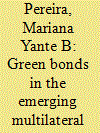|
|
|
Sort Order |
|
|
|
Items / Page
|
|
|
|
|
|
|
| Srl | Item |
| 1 |
ID:
178819


|
|
|
|
|
| Summary/Abstract |
Motivated by the lack of research on price efficiency dynamics of green bonds and the impact of the COVID-19 on the pricing of fixed-income securities, this study investigates the comparative efficiency of green and conventional bond markets pre- and during the COVID-19 pandemic applying asymmetric multifractal analysis. Specifically, the multifractal scaling behaviour is examined separately during upward and downward trends in bond markets using the asymmetric multifractal detrended fluctuation analysis (A-MF-DFA) approach. The empirical findings confirm the presence of asymmetric multifractality in the green and traditional bond markets. Not surprisingly, inefficiency in both bond markets significantly escalated during the COVID-19 outbreak. Furthermore, our results indicate a higher level of efficiency of the conventional bond market over the full sample period. However, the green bond market is more efficient during a black swan event, such as the COVID-19 global pandemic, showing the potential of green bonds to become an effective diversifier for investors in traditional assets in times of extreme market turmoil. The results of the study can have important implications for investors and policymakers.
|
|
|
|
|
|
|
|
|
|
|
|
|
|
|
|
| 2 |
ID:
180105


|
|
|
|
|
| Summary/Abstract |
With the promotion of the concept of green development on a global scale, various industries are pursuing high profit returns while also considering the harmony between human and nature. Green finance is put forward under this background. In this paper, 815 green finance and energy policy literatures are retrieved from the Web of Science database. We first carry out descriptive statistical analysis, including the overall growth, publication sources, research regions and high-level scientific research institutions. After that, we conduct clusters analysis to find the research hotspots in recent years and point out the research trends in the future. Important journals, scholars, research findings and future research focuses of green finance and energy policy are identified in this paper. The purpose of this paper is to promote the research and discussion of green finance, and to conduct a clear policy-related discussion on its impact on the energy field. Four possible green finance-related energy policies are also summarized. This research facilitates a systematic and comprehensive understanding of green finance and energy policy research, and offers that green bonds, government subsidies and carbon dioxide emissions are the research opportunities in the future, and further research can be done by combining Fintech, big data and blockchain.
|
|
|
|
|
|
|
|
|
|
|
|
|
|
|
|
| 3 |
ID:
186474


|
|
|
|
|
| Summary/Abstract |
Against the backdrop of the COVID-19 pandemic, the study explores the hedging and safe-haven potential of green bonds for conventional equity, fixed income, commodity, and forex investments. We employ the cross-quantilogram approach to understand better the dynamic relationship between two assets under different market conditions. Our full sample results reveal that the green bond index could serve as a diversifier asset for medium- and long-term equity investors. Besides, it can serve as a hedging and safe-haven instrument for currency and commodity investments. Moreover, the sub-sample analysis of the pandemic period shows a heightened short- and medium-term lead-lag association between the green bond index and conventional investment returns. However, the green bond index emerges as a significant hedging and safe-haven asset for long-term investors of conventional financial assets. Our findings offer valuable insights for long-term investors when their portfolios are comprised of conventional assets such as equities, commodities, forex, and fixed income securities. Further, our findings reveal the potential role of green bond investments in global financial recovery efforts without compromising the low-carbon transition targets.
|
|
|
|
|
|
|
|
|
|
|
|
|
|
|
|
| 4 |
ID:
166556


|
|
|
|
|
| Summary/Abstract |
Despite the emergence of the green bond market, the Energy Service Company (ESCO) model and green investment banks, the opportunities which the world's capital markets present to increase the pool of potential investors and reduce project financing costs for renewable, energy efficient and low carbon assets remain under-exploited. This has been a persistent concern for policy-makers. We review the appeal of this sector to different classes of investor and assess the successes and failures of several innovative products including securitisations, yieldcos, green bonds, green investment banks and crowdfunding. We analyse the experiences with these products and suggest that policy needs to recognise how fiscal initiatives can leverage their inherent appeal.
|
|
|
|
|
|
|
|
|
|
|
|
|
|
|
|
| 5 |
ID:
178466


|
|
|
|
|
| Summary/Abstract |
The article aims at discussing the rise of the green bonds in the context of the multilateral development banks, by problematizing their threats and potentialities to be an alternative to the existing financing system within the sustainable development agenda. It scrutinises the development rhetoric behind the emergence of multilateral development banks in the Global South, specifically in the Asian context, and attempts to foster alternatives to the Bretton Woods institutions. The two largest initiatives in that sense – the New Development Bank and the Asian Infrastructure Investment Bank – started in Asia and also target countries in the region, giving the growing influence of China and the enhancement of interregional cooperation through the BRICS countries, currently led by China, India and Russia. The paper argues that there is limited scope for the promised innovations in both project assessment and the role of private capital, given the prioritisation of infrastructure as the premise to achieving the right to development among emerging and least-developed economies. The research departed from the quantitative and qualitative analysis of the projects funded by the New Development Bank and the Asian Infrastructure Investment Bank, from their inception until 2018, considering the approach that such institutions have taken to the social and environmental standards from their normative framework.
|
|
|
|
|
|
|
|
|
|
|
|
|
|
|
|
| 6 |
ID:
182736


|
|
|
|
|
| Summary/Abstract |
This paper analyzes the reasons for the rapid increase in the scale of green bonds issued by Chinese commercial banks in recent years from the perspective of financing costs and regulatory arbitrage. Our empirical results show that the financing cost mechanism cannot explain this increase since the financing costs of green bonds are not lower than those of non-green financial bonds. Furthermore, commercial banks with low asset liquidity engage in regulatory arbitrage to take advantage of the convenience of green bond financing permission to supplement their liquidity. Our results imply that the regulatory arbitrage mechanism is a very important motivation for commercial banks to issue green bonds. To reduce this motivation and ensure the healthy and sustainable development of the green bond market, green ratings of projects should be linked with financing costs as a way to form a positive feedback incentivizing mechanism for green project financers.
|
|
|
|
|
|
|
|
|
|
|
|
|
|
|
|
|
|
|
|
|